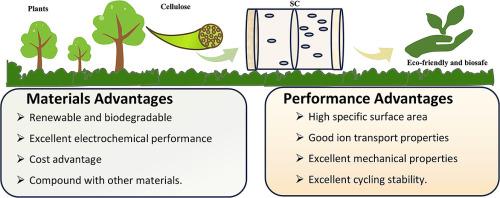Recent advances in sustainable cellulose-based supercapacitors: Diverse applications, crucial challenges, and coping strategies
IF 12.5
1区 化学
Q1 CHEMISTRY, APPLIED
引用次数: 0
Abstract
The rapid increase in global demand for energy storage devices has exacerbated environmental pollution, making the development of green, renewable materials imperative. Cellulose-based materials, with their ideal renewable and degradable properties, show notable potential and play a critical role in the sustainable development of energy storage devices, particularly supercapacitors (SCs). This review analyzes recent research progress and development trends related to cellulose and its derivatives in the field of SCs. First, the structural features, application advantages, and main preparation processes of cellulose are elaborated upon in detail. Subsequently, the current application status of cellulose-based materials in different components of SCs, including electrodes, binders, separators, quasi-solid electrolytes, and substrate materials, is systematically summarized in terms of their preparation techniques and raw material types, and the important role of cellulose in the future eco-friendly development of SCs is discussed in depth. Finally, the development trends of cellulose-based SCs and the obstacles they face are summarily discussed. This review aims to provide meaningful insights and references to support the sustainable development of SCs.

可持续纤维素基超级电容器的最新进展:不同的应用、关键的挑战和应对策略
全球对储能设备需求的快速增长加剧了环境污染,使得绿色可再生材料的发展势在必行。纤维素基材料以其理想的可再生和可降解性能,在储能设备特别是超级电容器的可持续发展中显示出显著的潜力和关键作用。本文综述了近年来纤维素及其衍生物在纳米纤维素领域的研究进展和发展趋势。首先,详细阐述了纤维素的结构特点、应用优势和主要制备工艺。随后,系统总结了纤维素基材料在纳米碳纳米管不同组分中的应用现状,包括电极、粘结剂、分离器、准固体电解质和衬底材料等,并对其制备技术和原料类型进行了综述,深入探讨了纤维素在未来纳米碳纳米管生态友好发展中的重要作用。最后,对纤维素基SCs的发展趋势和面临的障碍进行了总结讨论。本综述旨在为支持SCs的可持续发展提供有意义的见解和参考。
本文章由计算机程序翻译,如有差异,请以英文原文为准。
求助全文
约1分钟内获得全文
求助全文
来源期刊

Carbohydrate Polymers
化学-高分子科学
CiteScore
22.40
自引率
8.00%
发文量
1286
审稿时长
47 days
期刊介绍:
Carbohydrate Polymers stands as a prominent journal in the glycoscience field, dedicated to exploring and harnessing the potential of polysaccharides with applications spanning bioenergy, bioplastics, biomaterials, biorefining, chemistry, drug delivery, food, health, nanotechnology, packaging, paper, pharmaceuticals, medicine, oil recovery, textiles, tissue engineering, wood, and various aspects of glycoscience.
The journal emphasizes the central role of well-characterized carbohydrate polymers, highlighting their significance as the primary focus rather than a peripheral topic. Each paper must prominently feature at least one named carbohydrate polymer, evident in both citation and title, with a commitment to innovative research that advances scientific knowledge.
 求助内容:
求助内容: 应助结果提醒方式:
应助结果提醒方式:


